Netrokona Tourist Places: Netrokona, a town at the foot of the Garo hills, is also called the land of Mahua Malua. Haor – baor, canal-beel, river – nallah, grass, flowers, nunneries, and fertile agriculture are characteristics of the Netrokona district.
Netrokona is a small district full of beauty. It has many tourist spots to visit. There are Garo hills, the zamindar house of Susong Durgapur, the small Ethnic Cultural Academy, the Memorial of the tonk movement, the Dharmapalli of Saint Joseph, the Hajong Mata Rashimani memorial, the White Clay Hills. Balis sweets are a special attraction of this district.
Page Contents
6 Awesome Netrokona Tourist Places To Visit
1.Ethnic Cultural Academy/উপজাতীয় কালচারাল একাডেমী

The Autonomous Institute Ethnic Cultural Academy is located at Birishiri in Durgapur, 37 km from Netrokona district.
Among the small ethnic groups in Greater Mymensingh, the Ethnic Cultural Academy has been formed primarily to preserve the culture of the Hajong, Koch, Dalu, Mandai, Banai groups.
Small ethnic groups are rich in their language, social customs, clothing, food habits, rituals, and traditional culture. Throughout history, much of their cultural heritage has been lost to time.
In 1977, a special project of the Ministry of Culture established an Ethnic cultural academy on about 3.21 acres of land to showcase the culture of small ethnic groups in Bangladesh in the world sphere.
At present, the Cultural Academy is being run under the “Small Ethnic Cultural Act.”
The Ethnic Cultural Academy, which consists of various trees, has 4 branches such as culture, research, libraries, museums, etc. The Ethnic Museum on the 2nd floor preserves various patterns and used objects of the lives of small ethnic groups.
There is also an auditorium and guest house on the academy’s campus. Every year, many people from different parts of the country gather here for the cultural events of the tribals.
Entry Price & Schedule
Ethnic Cultural Academy is a tourist place in Netrokona. You can visit it with your family and friends and enrich your knowledge.
The entry fee to the Ethnic Cultural Academy is Tk. 2, and the entry fee to the museum is Rs. 10.
The academy’s museum is open for these 5 days from Sunday to Thursday of the week.
People Also Read: Amazing!! The Top 34 Best Travel Destinations In Bangladesh
2.Dingapota Haor/ডিঙ্গাপোতা হাওর – Tourist Spot in Netrokona
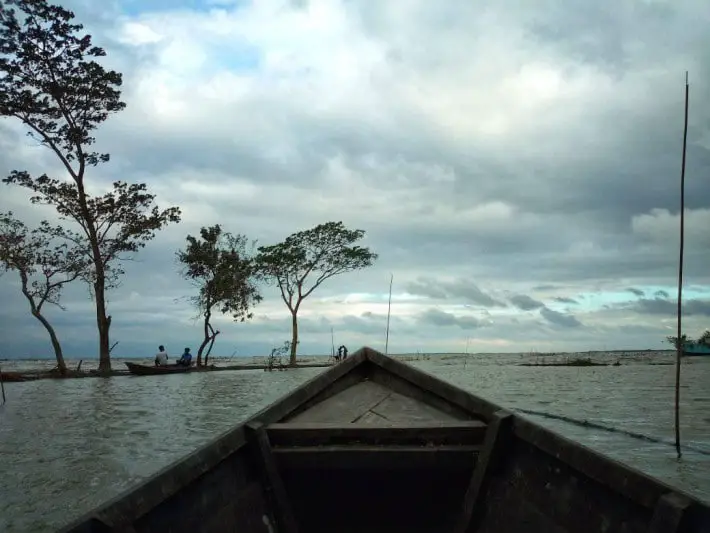
Dingapota Haor, located in Mohanganj Upazila of Netrokona district, is one of the largest haors in the country. The beauty of this Haor emerges in different forms from season to season. It is a stunning tourist spot in Netrokona.
Nature-loving visitors were fascinated by the stream of water in Haor during the rainy season and the stunning beauty around in the dry season.
However, all seasons, half-drowned hijal trees, the rising waves of water, and the blue sky, are visible in the deepest places of the huge waters of Haor.
Especially in autumn and late autumn, the green, golden paddy fields and blue skies on the two sides of Haor attract visitors the most.
During the fish season, temporary accommodation is available on the banks of the Haor for the fishermen and their families. It allows visitors to see the lives of the fishermen of Haor.
If you want, you can buy various fresh fish from Haor. Nature’s donation has opened the door to a huge potential in the tourism industry of the Stunning Dingapota Haor Netrokona district.
Netrokona district.
People Also Read: 5 Top Tourist Places To Visit In Jamalpur, Mymensingh
3.Komola Rani Dighi/কমলা রাণী দিঘী – Netrokona Tourist Place
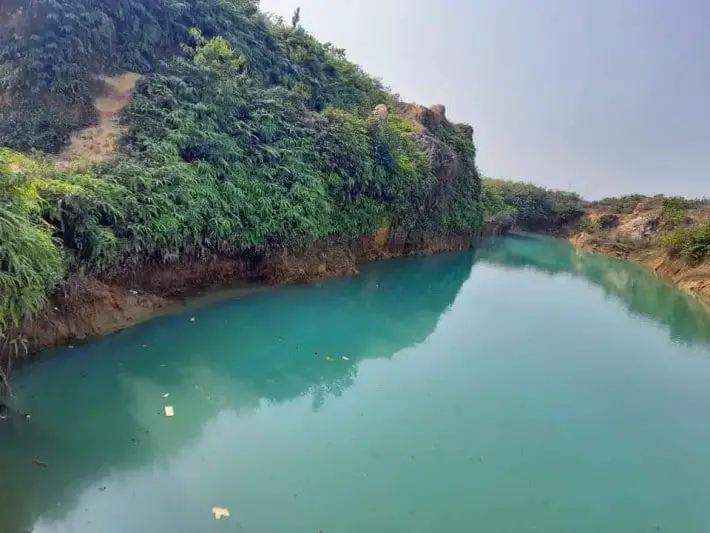
The traditional Komola Rani Dighi is located near The Birishiri Union Parishad, three kilometers from Durgapur Upazila Sadar. It is a tourist spot in Netrokona that can take to close the nature.
For many, it is also known as Sagar Dighi. In the late 15th century, Sussang married a beautiful Ramani named Janaki Nath Kamala Devi, king of Durgapur.
The son was born in the house of King Janaki Nath. The child was named Raghunath. King Janaki Nath dug a pond to address the water scarcity of the people. But the king was worried when the water did not rise in the pond.
Then one night, the king dreamt that the pond would be filled with water only if Queen Komola Devi went to the middle pond and offered prayers.
The queen also thought of the kingdom’s people and agreed to offer prayers in the middle of the pond. Suddenly, the water rose from all sides and drowned the Rani Komola.
According to many, the ground under Dighi burst swells with water due to lightning. King Janaki Nath was upset over such an incident. He always worried about the king’s son Raghu.
One night, the king dreamt that if he left his baby Raghu on the banks of the pond, queen Komola Devi would be able to breastfeed Raghunath.
But the condition is that the king will not be able to touch the queen in any way.
King Janaki Nath used to leave his child on the banks of the pond at night. Queen Komola Devi used to breastfeed her child and mix it again in the water.
One day the king went ahead with the desire to touch the queen. But the queen merged with the water. Since then, he has never come to feed his child.
The king dreamt that if his son Raghunath could have breast milked for another 7 days, he would have been considered a victorious and mighty hero.
History suggests that during the reign of King Raghunath, Susan Durgapur was established as a powerful Pargana. King Raghunath attacked the jungle house fort and defeated Vikrampur zamindar Chand Roy, Kedar Roy, and was awarded the title of Maharaja by the Mughal emperors.
At present, the Someshwari river flows through Komola Rani Dighi. The south and west banks of Dighi still survive as a witness to time. Accommodations have been built on the banks of the pond, and some parts are used as cropland.
People Also Read: The 8 Stunning Top Tourist Attractions In Sherpur, Mymensingh
4.Tomb of Seven Martyrs/Shat Sohider Mazar/সাত শহীদের মাজার
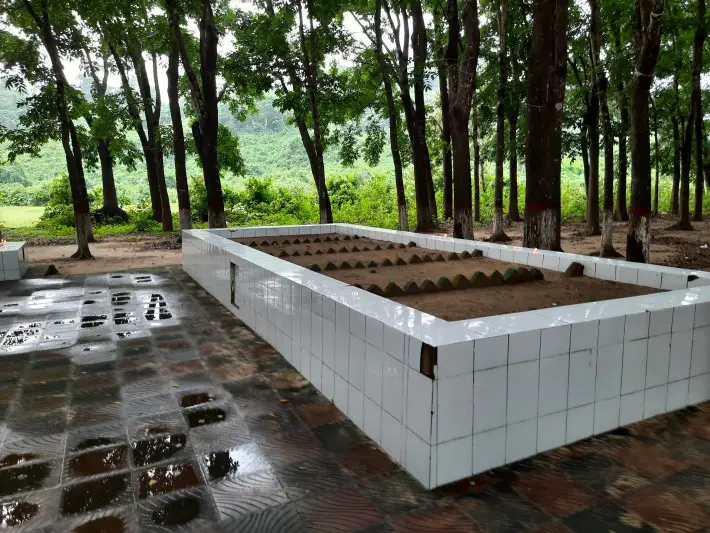
Phulbari is a quiet village on the Indo-Bangladesh border of Langura Union in Kamalakanda Upazila of Netrokona district. It is a historical place of Netrokona.
The Ganeshwari river flows through Garo hills from Meghalaya state in India through the village. There are several hills within our border, and the hill state of Meghalaya can be seen as far as the border is visible.
Seven freedom fighters are buried in the secluded place of the row of countless Mehogany trees all around. This place is known as the shrine of seven martyrs.
History
On July 26, Pakistani forces were planned to be attacked near the Nazirpur market on the Durgapur-Kalmakanda river route from Birishiri in Netrokona district to a pak army camp Kalmakanda.
According to the plan, the freedom fighters ambushed all the entrances to Nazirpur market. Long after the time was about to come, the freedom fighters suddenly faced the invading forces as they picked up their ambushes one by one.
The firing, the counter-firing, led to a fierce battle between the two sides. But the freedom fighters were largely unprepared for the surprise attack.
The freedom fighters entered the area. Yet, the freedom fighters continued to fight. It’s late in the morning, and till late in the afternoon; the war goes on.
In the afternoon, the attack by the Pak forces became more intense. In the meantime, when the commander of the freedom fighters was injured, the pace of the war changed.
Pak invaders captured some freedom fighters while armed and charged them with bayonets, and killed them. (Jamal Uddin, Dr. Abdul Aziz, Fazlul Haque, Yar Mamood, Bhavtosh Chandra Das, Nooruzzaman, Dwijendra Chandra Biswas. )
On July 27, they were buried and cremated on the border of India and Bangladesh at Phulbari in Langura.
5.Someshwari River, Durgapur/সোমেশ্বরী নদী, দুর্গাপুর
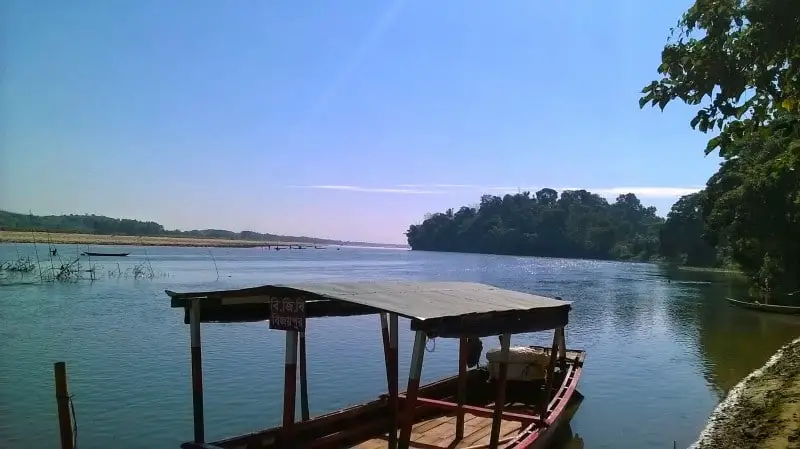
You have to go to Durgapur Upazila of Netrokona district to enjoy the Someshwari river and its beauty. The Someshwari river originates from Simsanggri in the Garo hills of Meghalaya, India, and enters Durgapur. It is a famous tourist attraction to see.
Someshwar Pathak occupied this area long ago, and it came to be known as the Someshwari River after him.
At different times of the year, the Someshwari river has a different beauty. Even if the water recedes in winter, the Someshwari river of ever-clean water should regain its youth in the monsoon.
Although now known as a coal mine, the Someshwari river has not been a bit of a beauty.
What else to see in Durgapur
It is best to hire a motorcycle or CNG to roam all day. You can rent a motorcycle in front of Talukdar Plaza in Durgapur and travel across the Someshwari River, from pink hills, Garo hills, blue water lakes of Chinese mud hills, Vijaypur BGB camp, Ranikhang Church, etc.
In addition, some pillars for the training of the liberation war in 1971 will be seen on the Indo-Bangladesh border.
People Also Read: 13 Top Tourist Attractions In Mymensingh You Should See!!
6.Birishiri/বিরিশিরি
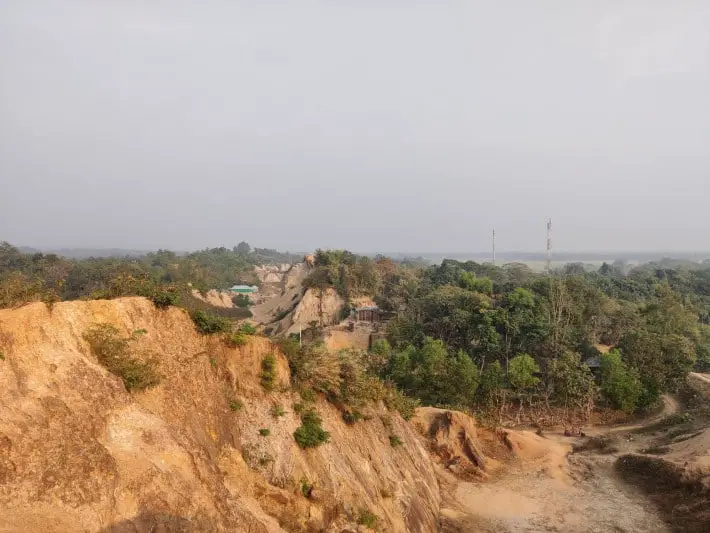
Birishiri is a traditional village located in Durgapur Upazila of Netrokona district. Birishiri is a famous tourist place in Netrokona. Every year lots of people go and visit this amazing natural beauty.
Vijayapur in Birishiri has attractive ceramic hills and blue water lakes. This ceramic hill and plain in Vijayapur extend about 16 km in length and 600 meters in width.
The blue water of the lake removes all fatigue and tiredness in no time. The main source of blue water in the lake is the Someshwari river.
This river is now better known as a coal mine. Like a lake of blue flames, the Someshwari river is stunning in its form.
What else to see in the Birishiri
The ceramic hills in Birishiri, the blue water lake are also ideal places for visiting the Someshwari River, Ranikhang Church, and The Dighi of the Komola Rani.
The beauty of Kashban and distant Garo hills on the banks of the Someshwari river impresses all the travelers who come to Birishiri.
During the rainy season, the Someshwari river matches all forms when tourists come and gather to see the beauty of the youth of Birishiri.
There are also hill cultural academies, Garo, Hajong, several monuments to the Tunka Revolution or Tebhaga movement in Hajong, and churches in St. Joseph’s.
